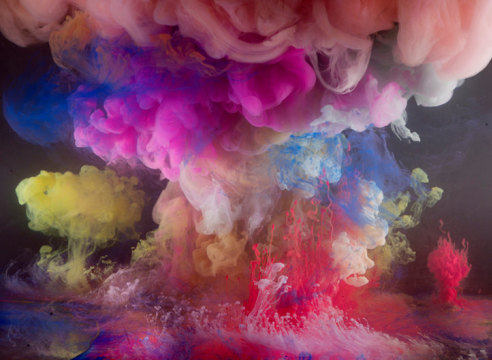
KIM KEEVER's spontaneous and expressive large-scale abstract photographs are created by pouring pigments into a 200 gallon tank of water, producing billowing blossoms and explosive clouds of color that he must quickly capture with his large-format camera.
He is also well-known for his large-scale landscape photographs, which are created by meticulously constructing miniature topographies in the empty tank, which is then filled with water. These dioramas of fictitious environments are next brought to life with colored light filters and the dispersal of pigment, producing ephemeral atmospheres that he must quickly capture with his large-format camera.
Keever's painterly panoramas represent a continuation of the landscape tradition, as well as an evolution of the genre. Referencing a broad history of landscape painting, especially that of Romanticism and the Hudson River School, they are imbued with a sense of the sublime. However, they also show a subversive side that deliberately acknowledges their contemporary contrivance and conceptual artifice.
Keever's staged scenery is characterized by a psychology of time and timelessness. A combination of the real and the imaginary, they document places that somehow we know, but never were. The symbolic qualities he achieves result from his understanding of the dynamics of landscape, including the manipulation of its effects and the limits of spectacle based on our assumptions of what landscape means to us. However, rather than presenting a factual reality, Keever fabricates an illusion that conjures the realm of our imagination.
Kim Keever studied Engineering at Old Dominion University, Norfolk, VA and worked briefly for the National Aeronautics and Space Administration (NASA). Keever decided to become a full-time artist in the mid 70s. His background in science and engineering has always helped him with various constructions concerning his work and the general thought process that is required of a scientist. Keever's landscapes are often associated with the Hudson River School and the German Romantic painters, though not intentionally.
Kim Keever lives and works in New York City and his work is in numerous collections, including: the Metropolitan Museum of Art, New York; Museum of Modern Art, New York; Brooklyn Museum of Art, Brooklyn; Hirshhorn Museum, Washington, DC; Virginia Museum of Fine Arts, Richmond, Virgina; Chrysler Museum, Norfolk, Virginia; Nassau County Museum of Fine Art, Roslyn, New York; Patterson Museum, Patterson, New Jersey; George Washington University Gallery, Washington DC; Nerman Museum of Contemporary Art, Kansas City, Missouri and Elgin Community College, Elgin, Illinois.